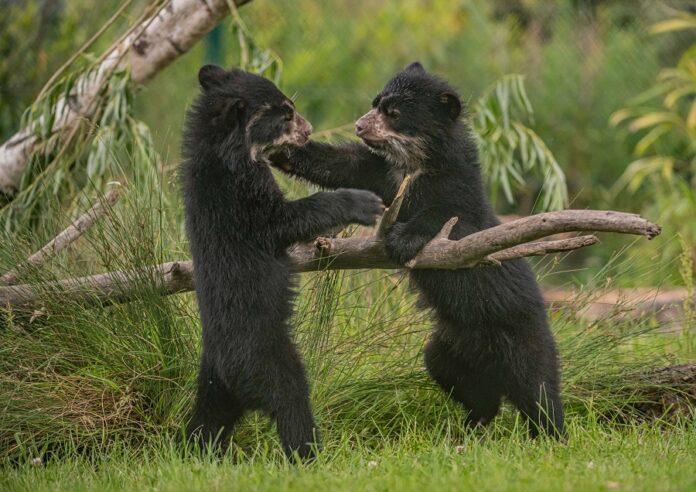The first set of Andean bear twins EVER to be born in the UK have emerged from their den at Chester Zoo.
The playful cubs were born in January, but have only now started to venture out and explore, having spent their first six months cuddled up by the protective side of their mum, Lima.
Revealed as one boy and one girl, the rare cubs were spotted enjoying some friendly rough and tumble and attempting to climb trees, before following mum back to their den for a well-deserved nap.
Our bear conservationists here at the zoo – which reopened this week after three months of closure – have named the adorable duo Pacha (female) and Mateo (male), and have hailed the birth of the cubs as “very, very special.” Experts estimate that fewer than 10,000 Andean bears remain in the wild.
“Andean bears are incredibly shy animals and, for this reason, are still something of a mystery to conservationists. So to see mum Lima allowing her two little cubs to explore so freely and enjoy a bit of friendly rough and tumble is just wonderful – it’s very, very special. The twin cubs are so full of energy and their playful personalities are really starting to show – it looks like they will be keeping mum very busy!” says Lucy Edwards, Chester Zoo’s Assistant Team Manager of Carnivores.
Lucy added: “Just a few weeks ago, while the zoo was closed, a small team of keepers and vets managed to give the cubs a quick check over and we’re very happy to report that both were given a clean bill of health. It’s great that we can now safely welcome back visitors and they can learn more about Andean bears and see the twins for themselves – an incredibly rare sight, even for conservationists studying them day in, day out in the field.”
Andean bears were originally made famous by the classic children’s character Paddington Bear who, although found in a London train station in the books, was known to be from ‘deepest, darkest Peru’.
Andean bears are the only species of bear to inhabit South America and, as well as Peru, they are found in Venezuela, Colombia, Ecuador and Bolivia. They are listed by the International Union for the Conservation of Nature (IUCN) as vulnerable to extinction.







